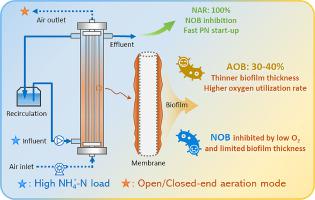当前位置:
X-MOL 学术
›
Water Res.
›
论文详情
Our official English website, www.x-mol.net, welcomes your feedback! (Note: you will need to create a separate account there.)
Establishing mainstream partial nitrification in the membrane aerated biofilm reactor by limiting the oxygen concentration in the biofilm
Water Research ( IF 11.4 ) Pub Date : 2024-06-21 , DOI: 10.1016/j.watres.2024.121984 Lisheng Wang , Congcong Zhang , Xiaofeng Kang , Yanchen Liu , Yong Qiu , Deqing Wanyan , Jiayin Liu , Gang Cheng , Xia Huang
Water Research ( IF 11.4 ) Pub Date : 2024-06-21 , DOI: 10.1016/j.watres.2024.121984 Lisheng Wang , Congcong Zhang , Xiaofeng Kang , Yanchen Liu , Yong Qiu , Deqing Wanyan , Jiayin Liu , Gang Cheng , Xia Huang

|
The proliferation of nitrite oxidizing bacteria (NOB) still remains as a major challenge for nitrogen removal in mainstream wastewater treatment process based on partial nitrification (PN). This study investigated different operational conditions to establish mainstream PN for the fast start-up of membrane aerated biofilm reactor (MABR) systems. Different oxygen controlling strategies were adopted by employing different influent NH-N loads and oxygen supply strategies to inhibit NOB. We indicated the essential for NOB suppression was to reduce the oxygen concentration of the inner biofilm and the thickness of aerobic biofilm. A higher NH-N load (7.4 g-N/(m·d)) induced higher oxygen utilization rate (14.4 g-O/(m·d)) and steeper gradient of oxygen concentration, which reduced the thickness of aerobic biofilm. Employing closed-end oxygen supply mode exhibited the minimum concentration of oxygen to realize PN, which was over 46% reduction of the normal open-end oxygen mode. Under the conditions of high NH-N load and closed-end oxygen supply mode, the microbial community exhibited a comparative advantage of ammonium oxidizing bacteria over NOB in the aerobic biofilm, with a relative abundance of of 30–40% and no detection of The optimal fast start-up strategy was proposed with open-end aeration mode in the first 10 days and closed-end mode subsequently under high NH-N load. The results revealed the mechanism of NOB inhibition on the biofilm and provided strategies for a quick start-up and stable mainstream PN simultaneously, which poses great significance for the future application of MABR.
中文翻译:

通过限制生物膜中的氧浓度在膜曝气生物膜反应器中建立主流部分硝化
亚硝酸盐氧化菌(NOB)的增殖仍然是基于部分硝化(PN)的主流废水处理工艺中脱氮的主要挑战。本研究调查了不同的操作条件,以建立膜曝气生物膜反应器 (MABR) 系统快速启动的主流 PN。通过采用不同的进水NH-N负荷和供氧策略,采用不同的控氧策略来抑制NOB。我们指出抑制NOB的关键是降低内部生物膜的氧浓度和需氧生物膜的厚度。较高的NH3-N负荷(7.4 g-N/(m·d))导致较高的氧利用率(14.4 g-O/(m·d))和较陡的氧浓度梯度,从而降低了好氧生物膜的厚度。采用闭端供氧模式,实现PN的最低氧气浓度,比普通开端供氧模式降低46%以上。在高NH-N负荷和闭端供氧模式条件下,好氧生物膜中微生物群落表现出铵氧化菌相对NOB的比较优势,相对丰度为30%~40%,且未检测到氨氧化菌。提出了在高 NH-N 负荷下前 10 天采用开放式曝气模式,随后采用封闭式曝气模式的最佳快速启动策略。研究结果揭示了NOB抑制生物膜的机制,为快速启动和稳定主流PN同时提供策略,对MABR的未来应用具有重要意义。
更新日期:2024-06-21
中文翻译:

通过限制生物膜中的氧浓度在膜曝气生物膜反应器中建立主流部分硝化
亚硝酸盐氧化菌(NOB)的增殖仍然是基于部分硝化(PN)的主流废水处理工艺中脱氮的主要挑战。本研究调查了不同的操作条件,以建立膜曝气生物膜反应器 (MABR) 系统快速启动的主流 PN。通过采用不同的进水NH-N负荷和供氧策略,采用不同的控氧策略来抑制NOB。我们指出抑制NOB的关键是降低内部生物膜的氧浓度和需氧生物膜的厚度。较高的NH3-N负荷(7.4 g-N/(m·d))导致较高的氧利用率(14.4 g-O/(m·d))和较陡的氧浓度梯度,从而降低了好氧生物膜的厚度。采用闭端供氧模式,实现PN的最低氧气浓度,比普通开端供氧模式降低46%以上。在高NH-N负荷和闭端供氧模式条件下,好氧生物膜中微生物群落表现出铵氧化菌相对NOB的比较优势,相对丰度为30%~40%,且未检测到氨氧化菌。提出了在高 NH-N 负荷下前 10 天采用开放式曝气模式,随后采用封闭式曝气模式的最佳快速启动策略。研究结果揭示了NOB抑制生物膜的机制,为快速启动和稳定主流PN同时提供策略,对MABR的未来应用具有重要意义。











































 京公网安备 11010802027423号
京公网安备 11010802027423号